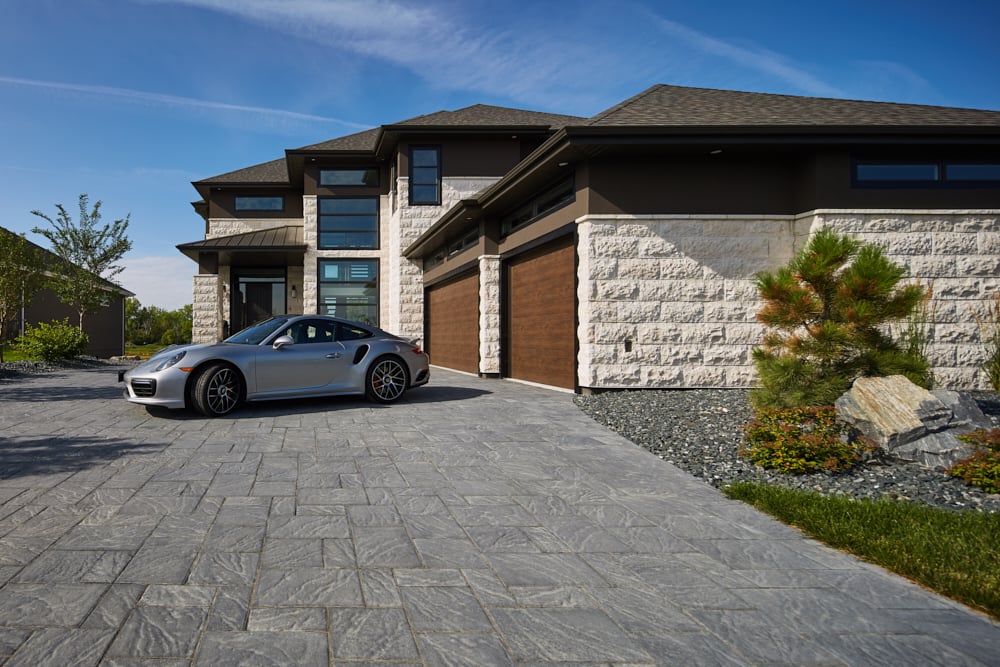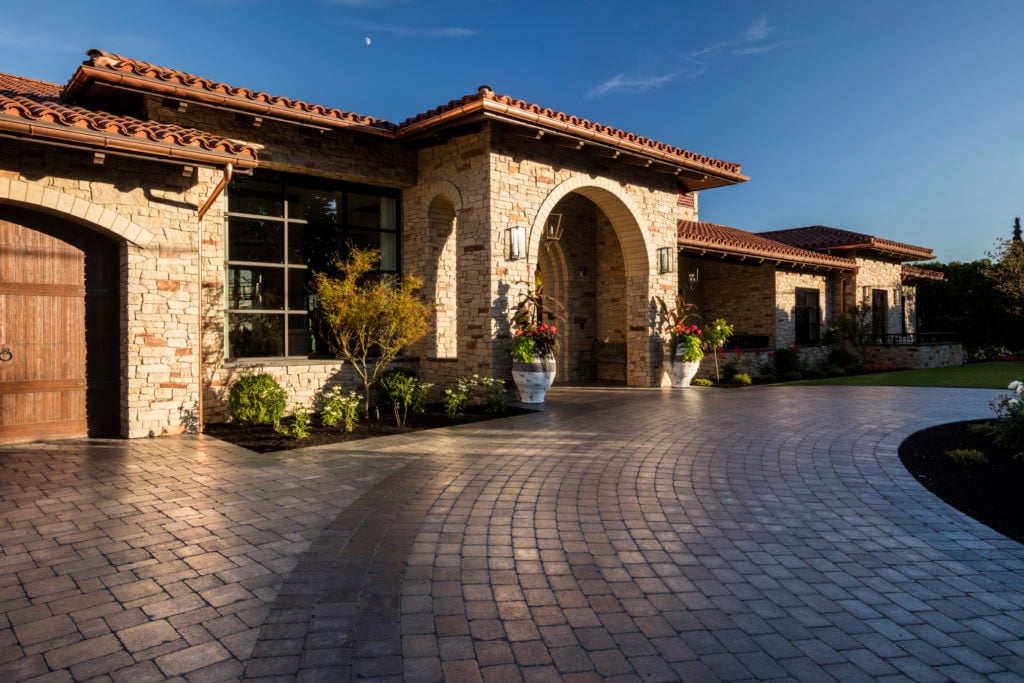Written by Peegy Ontong Published on June 2nd, 2022

Your driveway is a key element of your property. It needs to be durable and low maintenance. Because of this, most driveways have pour-in-place concrete slabs. But is it really the best option?
Concrete pavers are an alternate option when building a driveway. Their ability to be versatile and fit any landscape project make them an attractive choice when planning your space.
Of course, there are pros and cons to both options. Factors to consider are affordability, long-term benefits, installation and maintenance ease, and overall design and colour options.
What is the Difference between Poured Concrete and Concrete Pavers?
Poured concrete slabs are exactly what it sounds like. A rebar mold is created on your driveway space and the concrete is brought to the location and poured in. It then dries and sets, creating one complete slab of concrete.
Concrete pavers are precast, meaning they arrive at the location dry and ready to install. Pavers are installed by laying them down and locking them in with sand. They can be installed in multiple patterns and come in many different shapes.
Affordability
On average, pour-in-place concrete slabs are less expensive than concrete pavers. However, the money you save upfront can lead to additional costs later on. Poured concrete is susceptible to cracking during freezing weather and other underground disturbances, such as tree roots. Fixing poured slabs in targeted areas is not a seamless process, so they are usually ripped up and replaced, which ends up being costly in the end.
With pavers, the initial cost is higher, but their durability saves you from needing to replace or fix them as often as poured-in-place concrete. Since pavers are individual pieces, when one cracks, you can easily take it out and replace it. This saves time, money, and effort overall. In general, pavers are more resistant to freeze/thaw cycles, so cracking is less likely to occur.
Installation and Maintenance
While pavers may cost more to install, the process is relatively easy. Since they come dry and ready to install, there is no wait time for the product to dry down. A base is prepped by first excavating the area, then compacting a base material on top. This will ensure that your driveway will be even. Usually, a special bonding sand is used to lay the pavers. This will help keep the pavers in place, while also preventing weeds from growing in-between the cracks. Maintaining your pavers is also easy. A bristle brush and water with dish soap will keep them clean, but you can also use a pressure washer on a lower pressure. You can read more about paver care here.
On the other hand, poured-in-place concrete slabs are tedious when installed since there is a dry down time. During this time, you cannot use your driveway. Similar to laying pavers, poured concrete needs a prepped base to ensure your slab will be level. Instead of sand to reinforce the concrete, poured concrete uses rebar to keep it in place. Maintaining a poured driveway is easy, however, as you can use a pressure washer to hose it down or use soap and water like the process of cleaning pavers.

Long-term Benefits
As mentioned before, poured-in-place concrete is prone to cracking. It can shift during climate changes or be disturbed by moving soil or growing tree roots. If a product is prone to cracking, it may not be a great option in the long-term. A concrete slab driveway can last anywhere from 20 to 30 years. When factoring in resale value, needing to replace an entire driveway every 30 years does not seem like a permanent solution. Most people are not looking for projects to take on when buying a home.
Pavers, however, are crafted to last a lifetime. Because of their longevity, pavers make your home more desirable when factoring in resale values. Pavers are less prone to cracking since they displace water rather than absorb it and the sand used to bind them prevents roots and weeds from coming through. This means the likelihood of needing to replace the whole driveway is far less. Instead, you can replace single pavers as needed. Some pavers can also withstand nearly four times the amount of weight a pour-in-place concrete slab can, making them exceptionally durable for longer periods of time.
Design and Colour
One great option with pavers is that they are available in many shapes, colours and designs. They can look like natural wood, stone or even take on a modern look. Pavers allow for more customization and personalization. When installed professionally, they give a driveway, walkway, or patio a more refined look. Most pavers have a textured face to them which provides a better grip when walking. This is especially ideal for when concrete is wet to prevent any slips and falls.
Not all pour-in-place driveways are drab slabs of grey. There are options to dye the slab, but colours are limited. Another option is stamped concrete, where a design is stamped into the concrete to give the same effect as pavers. This is one way to get the paver style without paying paver prices. However, in places that have a variety of climate changes, like harsh winters, stamped or poured concrete can chip and crack or lose its colour. Stamped or poured concrete is also more of a slip hazard since it generally won’t have the same texture as a paver driveway would.
Overall, pavers offer the best solution for your driveway long-term. While they are costly upfront, their benefits far outweigh the cost. Pavers are easier to install with no wait time for things to dry, they are less prone to cracks and needing replacements due to their natural ability to displace water instead of soak it up, and it’s as easy as taking a brush and some soapy water to clean them off. Not to mention, they offer almost endless options with colours, sizes, shapes, and patterns, so you are able to design something you’ll love that stands out.












